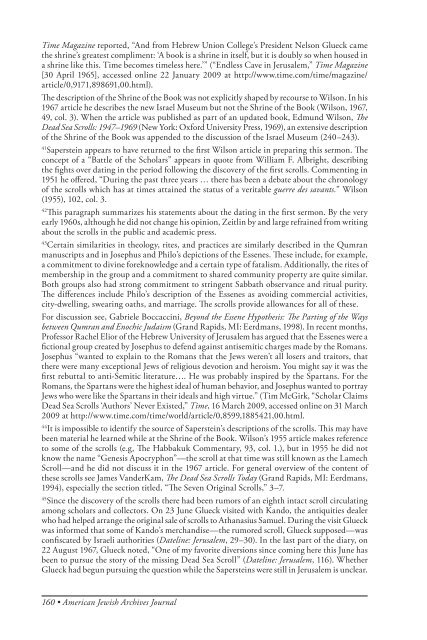The American Jewish Archives Journal, Volume LXI 2009, Number 1
The American Jewish Archives Journal, Volume LXI 2009, Number 1
The American Jewish Archives Journal, Volume LXI 2009, Number 1
Create successful ePaper yourself
Turn your PDF publications into a flip-book with our unique Google optimized e-Paper software.
Time Magazine reported, “And from Hebrew Union College’s President Nelson Glueck came<br />
the shrine’s greatest compliment: ‘A book is a shrine in itself, but it is doubly so when housed in<br />
a shrine like this. Time becomes timeless here.’” (“Endless Cave in Jerusalem,” Time Magazine<br />
[30 April 1965], accessed online 22 January <strong>2009</strong> at http://www.time.com/time/magazine/<br />
article/0,9171,898691,00.html).<br />
<strong>The</strong> description of the Shrine of the Book was not explicitly shaped by recourse to Wilson. In his<br />
1967 article he describes the new Israel Museum but not the Shrine of the Book (Wilson, 1967,<br />
49, col. 3). When the article was published as part of an updated book, Edmund Wilson, <strong>The</strong><br />
Dead Sea Scrolls: 1947–1969 (New York: Oxford University Press, 1969), an extensive description<br />
of the Shrine of the Book was appended to the discussion of the Israel Museum (240–243).<br />
41 Saperstein appears to have returned to the first Wilson article in preparing this sermon. <strong>The</strong><br />
concept of a “Battle of the Scholars” appears in quote from William F. Albright, describing<br />
the fights over dating in the period following the discovery of the first scrolls. Commenting in<br />
1951 he offered, “During the past three years … there has been a debate about the chronology<br />
of the scrolls which has at times attained the status of a veritable guerre des savants.” Wilson<br />
(1955), 102, col. 3.<br />
42 This paragraph summarizes his statements about the dating in the first sermon. By the very<br />
early 1960s, although he did not change his opinion, Zeitlin by and large refrained from writing<br />
about the scrolls in the public and academic press.<br />
43 Certain similarities in theology, rites, and practices are similarly described in the Qumran<br />
manuscripts and in Josephus and Philo’s depictions of the Essenes. <strong>The</strong>se include, for example,<br />
a commitment to divine foreknowledge and a certain type of fatalism. Additionally, the rites of<br />
membership in the group and a commitment to shared community property are quite similar.<br />
Both groups also had strong commitment to stringent Sabbath observance and ritual purity.<br />
<strong>The</strong> differences include Philo’s description of the Essenes as avoiding commercial activities,<br />
city-dwelling, swearing oaths, and marriage. <strong>The</strong> scrolls provide allowances for all of these.<br />
For discussion see, Gabriele Boccaccini, Beyond the Essene Hypothesis: <strong>The</strong> Parting of the Ways<br />
between Qumran and Enochic Judaism (Grand Rapids, MI: Eerdmans, 1998). In recent months,<br />
Professor Rachel Elior of the Hebrew University of Jerusalem has argued that the Essenes were a<br />
fictional group created by Josephus to defend against antisemitic charges made by the Romans.<br />
Josephus “wanted to explain to the Romans that the Jews weren’t all losers and traitors, that<br />
there were many exceptional Jews of religious devotion and heroism. You might say it was the<br />
first rebuttal to anti-Semitic literature…. He was probably inspired by the Spartans. For the<br />
Romans, the Spartans were the highest ideal of human behavior, and Josephus wanted to portray<br />
Jews who were like the Spartans in their ideals and high virtue.” (Tim McGirk, “Scholar Claims<br />
Dead Sea Scrolls ‘Authors’ Never Existed,” Time, 16 March <strong>2009</strong>, accessed online on 31 March<br />
<strong>2009</strong> at http://www.time.com/time/world/article/0,8599,1885421,00.html.<br />
44 It is impossible to identify the source of Saperstein’s descriptions of the scrolls. This may have<br />
been material he learned while at the Shrine of the Book. Wilson’s 1955 article makes reference<br />
to some of the scrolls (e.g, <strong>The</strong> Habbakuk Commentary, 93, col. 1.), but in 1955 he did not<br />
know the name “Genesis Apocryphon”—the scroll at that time was still known as the Lamech<br />
Scroll—and he did not discuss it in the 1967 article. For general overview of the content of<br />
these scrolls see James VanderKam, <strong>The</strong> Dead Sea Scrolls Today (Grand Rapids, MI: Eerdmans,<br />
1994), especially the section titled, “<strong>The</strong> Seven Original Scrolls,” 3–7.<br />
45 Since the discovery of the scrolls there had been rumors of an eighth intact scroll circulating<br />
among scholars and collectors. On 23 June Glueck visited with Kando, the antiquities dealer<br />
who had helped arrange the original sale of scrolls to Athanasius Samuel. During the visit Glueck<br />
was informed that some of Kando’s merchandise—the rumored scroll, Glueck supposed—was<br />
confiscated by Israeli authorities (Dateline: Jerusalem, 29–30). In the last part of the diary, on<br />
22 August 1967, Glueck noted, “One of my favorite diversions since coming here this June has<br />
been to pursue the story of the missing Dead Sea Scroll” (Dateline: Jerusalem, 116). Whether<br />
Glueck had begun pursuing the question while the Sapersteins were still in Jerusalem is unclear.<br />
160 • <strong>American</strong> <strong>Jewish</strong> <strong>Archives</strong> <strong>Journal</strong>

















